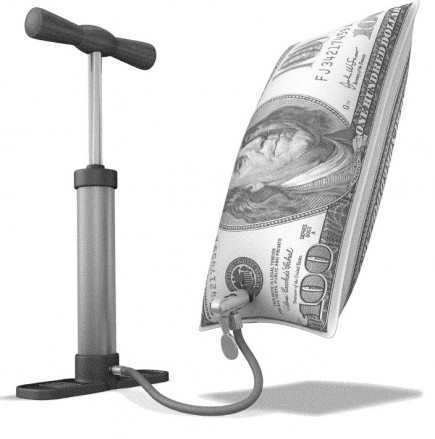The Fed Should Inflate to End the Financial Crisis The Freeman Foundation for Economic Education
Post on: 16 Март, 2015 No Comment

Continued Inflation Would Postpone the Day of Reckoning
The current housing and financial crisis has many people blaming “greed and market forces” for unleashing a panoply of evils on the unsuspecting middle class. This has led to many bad proposals to solve the crisis, such as the April 14 Wall Street Journal op-ed “The Inflation Solution to the Housing Mess” by John Makin, a visiting scholar at the American Enterprise Institute.
His theme: “In my view, the least bad option is for the Federal Reserve to print money to help stabilize housing prices and financial markets. Yes, use reflation to soften the pain for Main Street and Wall Street.” Makin justifies this proposal by claiming that a continued drop in housing prices will lead to the nationalization of the mortgage business, and thus inflation is the lesser of the two evils. But what if the current crisis is the result of the Feds easy-money policy? Hair of the dog is a bad idea for housing crises as well as hangovers.
Our current economic problems stem from the 2002–06 real-estate bubble. Falling mortgage rates during that period (roughly 7–8 down to 4–6 percent, depending on the mortgage type) led to a refinancing mania and bidding wars among buyers. Many individuals bought homes they could not afford in the hopes that values would rise fast enough to allow them to refinance the mortgages before the high payments kicked in. Almost everybody believed that house prices would continue to go upward without limit, thus creating a bubble. These actions by homebuyers and banks were rational responses to distorted signals carried by prices that were no longer reflecting the true scarcity of housing. The signals were distorted by the Feds easy-money policy.
The Fed engages in a countercyclical policy: stimulate the economy when it begins to slow down and dampen it when it gets “overheated.” The Fed stimulates by injecting new money into the market, and takes away the stimulus by removing money from the economy. It injects new money into the system by buying Treasury bonds from banks, a process called open-market operations. When the Fed buys the bonds, private banks get the newly created money (called reserves). The forces of competition among banks flushed with new money drive down the price of borrowing—the interest rate—which increases consumption and investment, stimulating the economy.
The problem is that the Fed stimulated too deeply and for far too long. Responding to the recession of 2001, it lowered the federal funds rate (the Feds main interest-rate target) from 6.5 percent in January 2001 to 1 percent in June 2003, kept it there for a full year despite the fact that the recession ended in late 2001, and then slowly brought it back up over the following two years. The monetary base, the fundamental measure of monetary liabilities created and directly controlled by the Fed, went up 30 percent between December 2000 and December 2004—a significant increase. That large amount of new liquidity first went into bank vaults, from where it was loaned out. The problem was that this liquidity was artificial: it did not consist of individuals savings, their forgone consumption and sacrifices. It thus fooled most people into thinking that they had somehow escaped the bounds of scarcity—that they could have their cake and eat it, too.
Low interest rates made borrowing attractive, and people responded by buying homes either to live in or as investments, driving up demand and prices. Banks started cutting back on credit checks when doling out mortgage loans, a fact that some now blame for the bubble. And it is true that the bubble was most certainly exacerbated by securitization, which allowed banks to sell their mortgages to hedge funds and avoid holding risky loans. This created incentives for banks to seek out the high-risk marginal borrowers. Hence the infamous “NINJA” loans—No Income, No Job, No Assets.

However, banks were simply responding to the distorted signals in the real-estate markets. Finding themselves swimming in money, they did the only thing they could to get rid of it all: lower the standards on who could get the mortgage loans. As long as housing values were going up so rapidly, they couldnt lose by making loans, even to high-risk borrowers.
So if the Feds expansion of liquidity is the cause of the current mess, can more of it save us? Indiscriminately pumping up liquidity will certainly lead to price inflation, of which there are now increasing signs. When the Fed last opened the money spigots, we saw the dollar plummet against all major currencies, leading to a dramatic rise in the price of oil, commodities, and food. The media and the politicians seem utterly oblivious to the monetary cause of these problems. We are already beginning to deal with the consequences of inflation: cost-of-living increases as prices rise faster than our incomes, destruction of our savings, difficulties setting long-term contracts under inflation uncertainty, and maybe most important, distortions of relative prices, making economic calculation by entrepreneurs and consumers much less reliable.
Its not surprising that Wall Street wants to be bailed out through inflation. They would receive the benefits of the increased liquidity while the rest of us would bear the costs. Their profits would remain private while their losses would be socialized and spread out among the rest of the society through inflation. It is exactly this kind of policy that contributed to the current mess. In 1998 the Long-Term Capital Management hedge fund was deemed “too big to fail” and was bailed out. In the process, the Fed created a severe moral hazard: by protecting some people from the downside of their risky actions, the central bank encouraged such actions. The Feds bailout policy is at least partly responsible for the Wall Street excesses; the hedge funds came to expect that the Fed would not chance a failure of the financial system. The so-called “Greenspan put” is now clearly the “Bernanke put.”
If the Fed continues to inflate, as Makin recommends, it would simply postpone the day of reckoning. Rather than letting the bad investments be cleared out now, reflation would further distort relative prices, likely leading to significant errors down the road and more bubbles in other sectors (as may already be happening in the commodities markets). This is how one crisis begets a bigger one. We must allow the distortions introduced by the activist Fed to be discovered and corrected. The odds that the government will eventually nationalize the mortgage markets will be much higher if the current crisis is treated by planting the seeds for a much bigger one in the future.














